Shameless exploitation
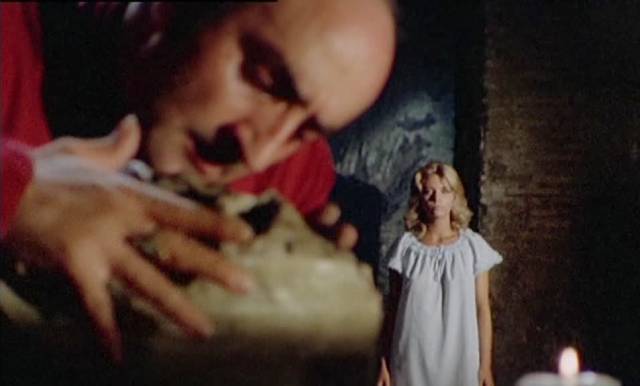
Shameless is a British label which has been around since 2007, dedicated to exploitation movies, generally European, with an emphasis on the sleazier end of the spectrum – somewhat like Severin, Code Red or Blue Underground. I’ve been aware of it for years, but from what I’d read their quality was often somewhat iffy. There were also suggestions that they sometimes messed with the editing of the films they released – this may partly be a result of the need to piece together a transfer from multiple compromised sources, but being located in England it may also occasionally have been due to censorship issues (as with Umberto Lenzi’s Cannibal Ferox, in which they took it on themselves to replace some of the animal cruelty with alternate footage). In addition, although they released their first Blu-ray in 2011, they still mostly put out DVDs, which means in addition to picture quality issues there’s the drawback of PAL speed-up (movies made at 24 frames a second are transferred at 25 fps, a 4% acceleration resulting in a shift in soundtrack pitch) – I’m not as bothered by that as much as some people, but it’s always preferable to find an NTSC disk if it’s available.
Until recently, the only Shameless disk I’d bought was Dick Maas’ Dutch giallo Amsterdamned (1988, which I’ve just replaced with the Blue Underground Blu-ray). Then at the end of May it somehow came to my attention that the company had an online sale and, stir-crazy from social distancing and working from home, I scoured their catalogue and placed an order. A couple of items were movies I already knew, but most of them were new to me and bought purely on spec. With time on my hands, I watched all nine movies in three days, beginning with what looked like the sleaziest and working up to the ones I already knew I liked. The quality was definitely variable, both in terms of the source materials (inevitably some of these movies have survived only in compromised form, with plenty of print damage), but also in the transfers themselves. Of the two Blu-rays in the batch, one is absolutely pristine, while the other has serious problems with the encoding, making for poor contrast and murky blacks frequently devoid of detail … a real problem given that so much of the movie takes place at night and in poorly lit interiors.
But before I get to those, I’ll deal with the DVDs in the order I watched them.
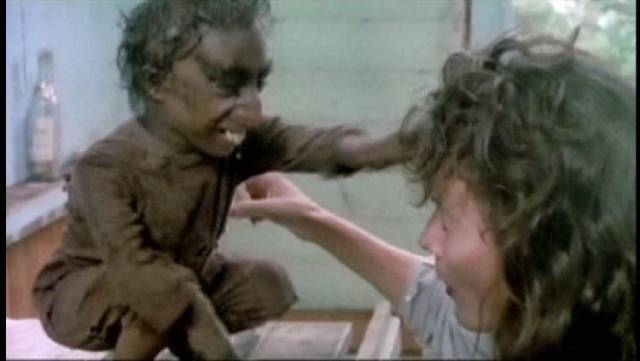
Ratman (Giuliano Carnimeo, 1988)
In the 1960s and ’70s, Giuliano Carnimeo specialized in westerns (I’m only familiar with his four Sartana movies) before turning almost exclusively to comedies until he retired in the late ’80s. In 1983, he tried his hand at the Mad Max-inspired post-apocalypse genre with Exterminators of the Year 2000, but nothing he had previously done pointed towards his second-last feature. Touted by Shameless as one of the sleaziest movies ever made, Ratman (1988) turns out not to be as offensive as advertised. Unless you count the use it makes of Dominican actor Nelson de la Rosa, at 28 inches one of the world’s shortest people. Best known as Marlon Brando’s mini-me in John Frankenheimer’s The Island of Dr. Moreau (1996), here he plays the titular monster.
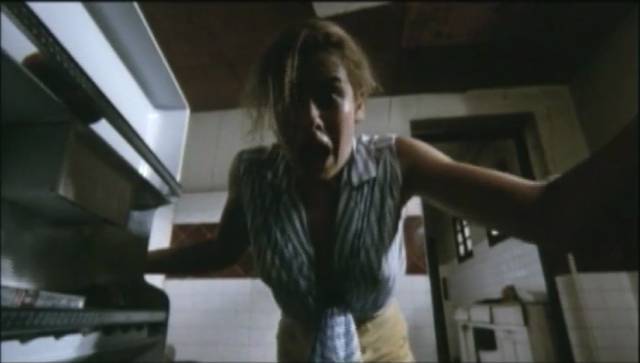
In addition to de la Rosa and some scantily-clad actresses, the chief appeal of Ratman is the presence of David Warbeck, an English actor who always had a relaxed and likeable presence no matter what might be going on around him (he starred in Lucio Fulci’s The Black Cat and The Beyond [both 1981] among others). Here, Warbeck is a writer vacationing in the Caribbean who stumbles into the story when he meets an American woman (Janet Agren) who has come to the Island looking for her missing sister. The sister is a model who’s doing a photo shoot on the island and the police have contacted the family because they believe she’s turned up in the morgue. That turns out to be a case of mistaken identity, and when the writer decides to help the woman search for her sister, they both end up running into the diminutive monster.
De la Rosa plays a critter who’s the result of a doctor’s genetic experiments. The doc apparently expects to win the Nobel Prize for splicing together rat and monkey DNA (for no discernible reason), resulting in a vicious creature with fangs and claws that drip with fast-acting poison. When the critter escapes, people start turning up dead, torn apart and partially eaten. For the first half of the movie, the Ratman is barely seen, but as the writer and woman close in, de la Rosa is shown more clearly, baring his fangs and tearing into victims.
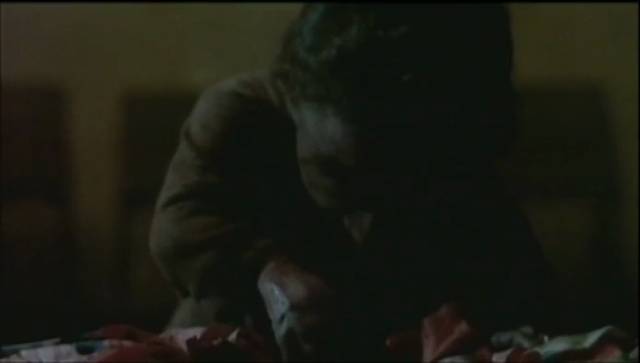
Before we get there, though, an awful lot of time is spent on the photographer and his models taking pictures on the beach and in the jungle. When they come across mutilated bodies, they don’t tell anyone because they “don’t want to get involved”. So they keep shooting and eventually all end up victims.
Poorly paced and clumsily constructed, it’s surprising that Ratman’s script was by Dardano Sacchetti, one of the masters of Italian exploitation who produced key scripts in every genre (beginning spectacularly in 1971 with Dario Argento’s The Cat o’ Nine Tails and Mario Bava’s Bay of Blood). This movie gives the impression of having been tossed together to take advantage of de la Rosa and the Dominican locations, with Carnimeo doing a perfunctory job and making sure that he tosses in a bit of nudity or gore at regular intervals. As my friend put it, too many photo shoots, not enough Ratman.
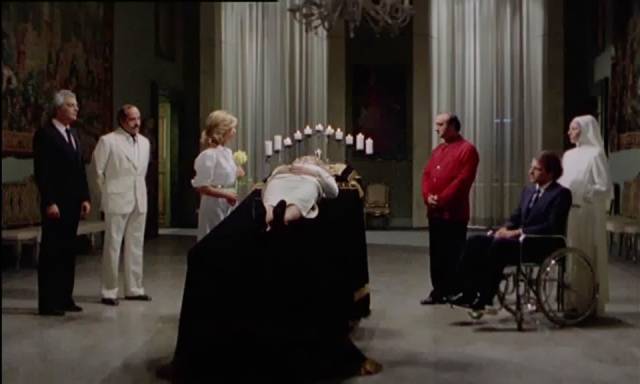
Satan’s Baby Doll (Mario Bianchi, 1982)
I’m even less familiar with the work of Mario Bianchi, an incredibly prolific director who racked up more than a hundred credits in thirty years. That record goes a long way towards explaining the particular qualities of Satan’s Baby Doll (1982), a movie which makes the perverse and murderous doings of a degenerate aristocratic family seem completely matter-of-fact. Set in an impressive decaying castle, the story begins with everyone gathered around the dead body of wife and mother Maria Aguilar (Marina Hedman). When teenage daughter Miria (Jaqueline Dupre) enters the room, the corpse abruptly sits up and the girl faints. The doctor helpfully explains that this was merely a postmortem spasm. Don’t believe it.
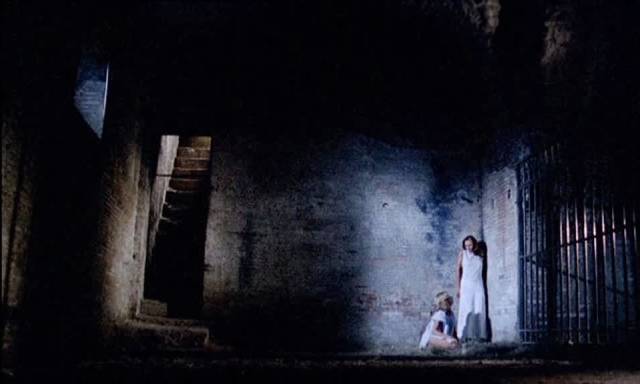
Maria hated her family and she takes possession of Miria in order to get her revenge. Meanwhile, family retainer Isidro (Giuseppe Carbone) is in the cellar conducting black magic ceremonies, though it’s never clear whether he’s trying to aid or stop Maria. Meanwhile nun Sol (Mariangela Giordano) teases her voiceless paraplegic charge Ignazio Aguilar (Alfonso Gaita) by leaving her bedroom door open so he can spy on her as she strips off and pleasures herself. Patriarch Antonio Aguilar (Aldo Sambrell) is pressuring Sol for sex, partly because he knows that she and Maria were lovers. And so it goes, with Maria’s malevolent spirit stirring the pot of sex and death until the family is destroyed.
Someone like Mario Bava or even Antonio Margheriti could have made an evocative Gothic nightmare out of the material, but Bianchi just gets the job done, depending on the cast to add something to the basics (a few of them manage to breathe a bit of energy into the proceedings) while cinematographers Angelo Lannuti and Franco Villa make good use of the castle location to generate some visual interest.
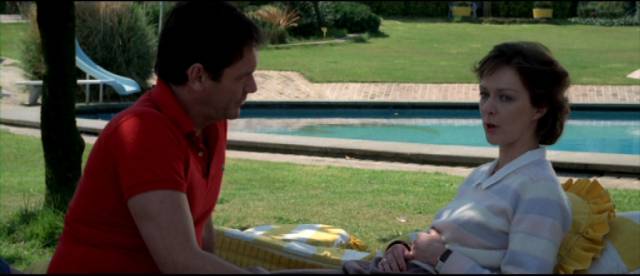
in Alberto De Martino’s Formula for a Murder (1985)
Formula for a Murder (Alberto De Martino, 1985)
By an odd coincidence, the plot of Alberto De Martino’s Formula for a Murder (1985) bears a strong resemblance to Sidney Gilliat’s Endless Night (1971), which I recently watched for the first time. I know De Martino primarily for his two mid-’70s horror movies, L’anticristo (1974) and Holocaust 2000 (1977). This later effort seems much less flamboyant, a rather routine woman-in-jeopardy romantic suspense story in which physical therapist Craig (David Warbeck again) overcomes the resistance of wheelchair-bound Joanna (Christina Nagy) and persuades her to marry him, much to the annoyance of her helper-companion Ruth (Carroll Blumenberg).
Needless to say, motives are not what they seem and Joanna, who suffers from PTSD from having been raped as a child by a man dressed as a priest, seems to be experiencing increasingly disturbing hallucinations which gradually take on real menace. She has to sort out what’s real from what’s just in her mind and eventually has to overcome her physical limitations to fight for her life.
De Martino does a competent job of generating suspense and the cast are engaging. Although the movie never transcends its basic genre parameters, it does succeed within those constraints.
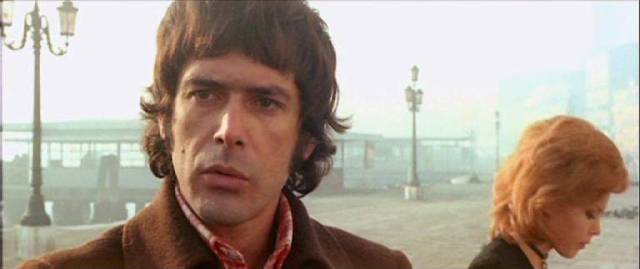
in Maurizio Lucidi’s The Designated Victim (1971)
The Designated Victim (Maurizio Lucidi, 1971)
Yet another unknown, Maurizio Lucidi went from sword-and-sandal epics, westerns and war films through comedies and eventually on to porno, but along the way he made The Designated Victim (1971), an unacknowledged variation on Patricia Highsmith’s Strangers on a Train and the 1951 Hitchcock adaptation of the novel. Although there are some plotting issues, the movie benefits from locations in Milan and Venice and, most importantly, from Tomas Milian and Pierre Clementi in the lead roles.
Milian is Stefano Augenti, a businessman chafing at being under the financial control of his wife Luisa (Marisa Bartoli). He wants to sell their stock and embark on a new life, but she won’t let go, so he decides he’ll have to forge some documents, sell the stock and, leaving her a chunk of money, head for South America with his mistress, Fabienne (Katia Christine). On a business trip to Venice with Fabienne, he meets a strange, rather effete nobleman, Count Matteo Tiepolo (Clementi), who is generous and helpful.
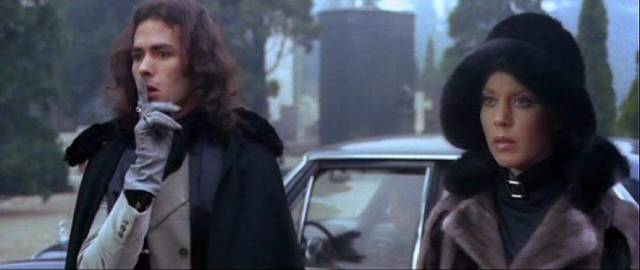
Back in Milan, as Stefano works on his illicit plan, he keeps “accidentally” encountering Matteo … it quickly becomes apparent that the Count is looking for something and, confronted, he proposes that the two of them swap murders; he’ll kill Stefano’s inconvenient wife and Stefano will kill Matteo’s brother, who apparently is an intolerable sibling. Stefano doesn’t take this seriously, yet after an argument with Luisa he leaves home, spending the night with a German woman he picks up on the street. In fact, there are a series of details which Stefano doesn’t pay much attention to which together provide him with a potential alibi for the night.
The next morning, however, when he discovers that Luisa has been murdered, those details seem to evaporate and the police are openly suspicious of him … even more so when they begin to uncover his plans for a massive financial crime at his wife’s expense. Things go from bad to worse as Matteo begins to put more pressure on him – turns out Matteo had arranged for the meeting with the German woman, and she had taken a key piece of material evidence that might have helped to clear him. And then it gets even worse, because Matteo begins to systematically unravel Stefano’s life…
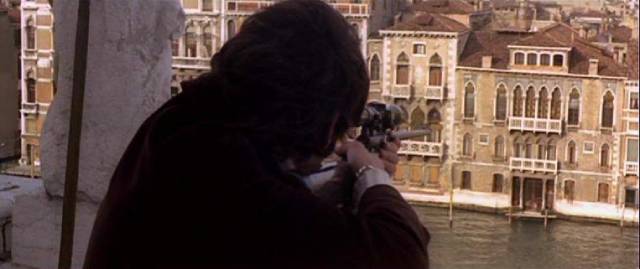
This is where the Strangers on a Train concept comes apart; the whole point of that story was that there should be no visible connection between the two men, but here Matteo becomes a stifling presence, gradually feeding the police (and Fabienne) clues that make Stefano look increasingly guilty. Becoming desperate, Stefano is more easily manipulated … his only hope is that Matteo will be able to restore evidence of his alibi (although the police now know about his attempted fraud), so he goes ahead with the plan to kill Matteo’s brother as the police and Fabienne race to stop him. Whatever happens at this point, he’s lost and it seems that the entire plot has been badly misconceived.
It’s only in the final moments that we understand Matteo’s actual plan and that Stefano was being used without any regard for him being able to get away.
The film’s chief pleasure is in seeing the usually self-assured Milian fall apart under the louche influence of Clementi, the embodiment of bored decadence – and seeing it happen on those great locations shot by Aldo Tonti.
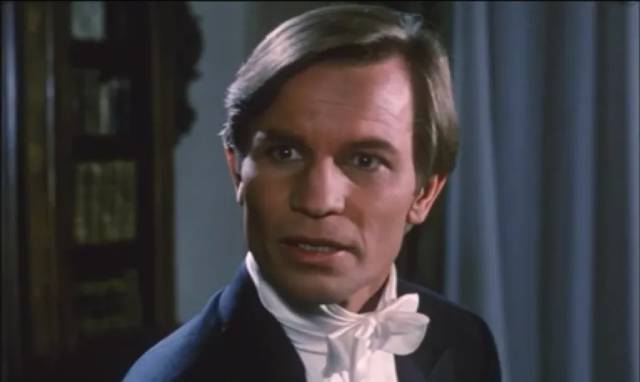
Phantom of Death (Ruggero Deodato, 1988)
Of the films I hadn’t previously seen, the one I found most surprising was Phantom Of Death (1988). Coming from Ruggero Deodato, the director best known for the extreme violence of Cannibal Holocaust and The House on the Edge of the Park (both 1980), it confounded my expectations; beginning like a giallo, it transforms after half-an-hour into a monster movie which ends up being quite sympathetic with the all-too-human monster.
Robert Dominici (Michael York) is a concert pianist whose career is taking off. He has a fiance, Susanna (Mali Galan), who is a bit worried that his success will come between them. He’s attracted the attention of Helene Martell (iconic giallo presence Edwige Fenech) and in his spare time practices martial arts, both bare-handed and with a katana. Around the time of a televised concert, a woman is brutally killed in her home – this is Dr. Carla Pasenti (Carola Stagnaro). The detective on the case, Inspector Datti (Donald Pleasence), has a suspicion that she was killed by one of her patients in order to cover up some medical issue.
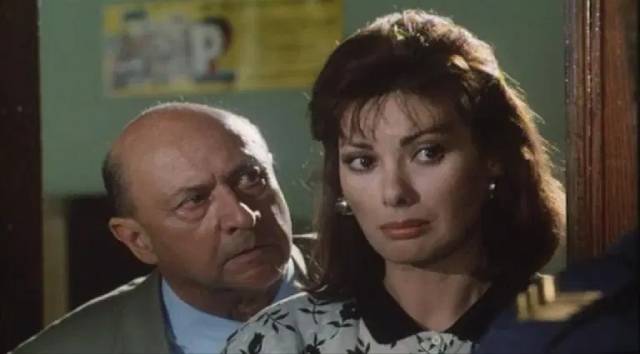
Soon after, Susanna is also brutally killed as she heads for Robert’s apartment. While Robert seems devastated by her death, Datti isn’t convinced and quickly comes to suspect the pianist. While that may seem like a bit of jumping to conclusions, the truth is quickly revealed to the audience: Robert has been struck with progeria, a rare genetic disease which usually manifests in childhood, and his entire life is essentially over. His body is suddenly growing old at a drastically accelerated rate and pretty soon there’ll be no career, no romance…
As he falls apart, anger turns to madness and he kills again. He makes anonymous taunting phone calls to Datti, claiming responsibility for the crimes and predicting further deaths … tormented by what he is becoming, he wants to be stopped but is unable to stop himself. Datti is confused because he’s positive that Robert is the killer but witnesses see a much older man. Eventually, Robert turns his attention to Helene and reveals himself to her – now a pathetic, deformed creature (who bears some resemblance to the later stages of Seth Brundle’s mutation in David Cronenberg’s The Fly [1986]), he sets himself up to be caught finally by Datti just before he dies of old age.
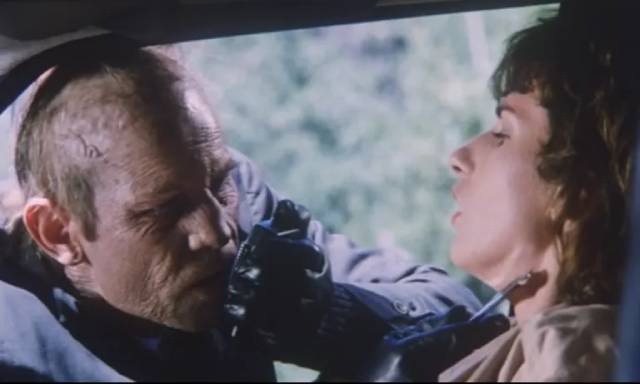
Given the cruelty of his best-known work, Deodato here injects genuine emotion and pathos into Robert’s nightmarish condition. Although he responds to his illness in unacceptably anti-social ways, he is himself a victim of something terrible. Coming late in the giallo cycle, Phantom of Death is steeped in atmosphere – it was shot by Giorgio Di Battista, with a score by Pino Donaggio – and Deodato maintains suspense through character rather than a traditional mystery plot. Plus, the cast is excellent, with York in a very atypical role and Pleasence fully committed even if his Datti does bear some resemblance to Halloween’s Dr. Loomis.
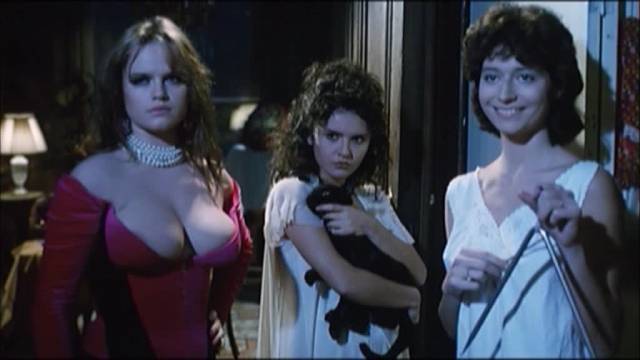
The Washing Machine (Ruggero Deodato, 1993)
Deodato’s The Washing Machine is something else again. Shot in Budapest, in English, with excellent moody photography by Sergio D’Offizi, and amped up by a score whose first three notes declare unequivocally that the composer was Claudio Simonetti, it mixes giallo and horror with rather a lot of sex and ends up being really irritating. It begins with an argument between Vida Kolba (Katarzyna Figura), a prostitute, and her pimp Yuri Petkov (Yorgo Voyagis), which ends in sex by an open fridge in the kitchen of a huge apartment, with Vida’s sister Ludmilla (Barbara Ricci) watching from the shadows. Vida finally kicks Yuri out, telling him never to come back; and that night, Ludmilla hears the washing machine running and goes to look, finding blood streaming from it and Yuri’s dismembered body in the drum.
When Inspector Alexander Stacev (Philippe Caroit) is called in, he finds no sign of the body, the blood, or anything out of the ordinary. He’s told that Ludmilla drinks heavily and probably dreamed it all. But there’s something off about Vida, Ludmilla and their other sister Maria (Ilaria Borrelli). Although there’s no official case, Stacev keeps tabs on the three women, alienating his girlfriend Irina (Claudia Pozzi) in the process. He seems to be stripped of all autonomous will, each sister in turn engaging him in kinky sex which, although obviously not a good idea, he can’t resist.
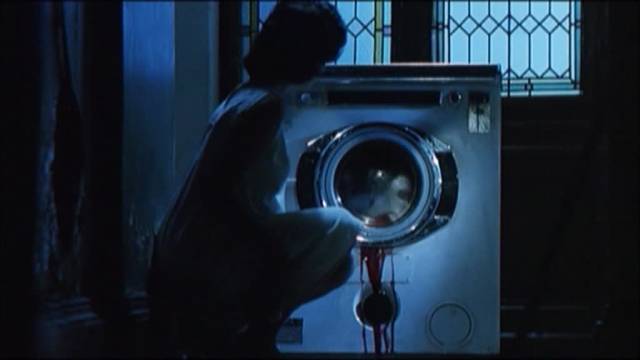
Stacev’s helplessness becomes incredibly irritating because there’s no apparent psychological or narrative logic to it. With the gloomy settings and the rather ferocious sexuality of the sisters, it’s easy to start suspecting that they are some kind of mythical creatures, like Sirens transplanted into an oppressive post-Communist city. But despite the uncomfortable, atmospheric build-up, the final revelations offered by the script are a massive letdown, turning the whole thing into a perverse joke. After the sisters’ unsettling, predatory sexuality and Stacev’s frustrating lack of agency the audience deserves more than a trite crime to explain it all.
Deodato’s skill at creating individual scenes, exploiting visually interesting locations, and the committed work of an obviously talented cast all seem somewhat wasted on a script that begins imaginatively but fumbles narrative development and the ending.
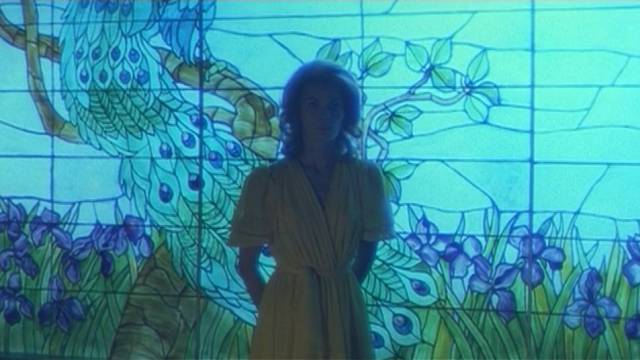
Le Orme aka Footprints on the Moon (Luigi Bazzoni, 1975)
The other three films I’d previously seen, most recently Luigi Bazzoni’s Le Orme (1975), released by Shameless on DVD under the alternate title Footprints on the Moon (which happens to be the title of the science fiction film-within-a-film starring Klaus Kinski which has haunted the protagonist since childhood). As I mentioned in my earlier post, the film is more of an Alice Through the Looking Glass story of a woman (named Alice in case you missed the point) losing her grip on reality than an actual giallo. The lush photography by Vittorio Storaro and Florinda Bolkan’s superb lead performance make of the film a languid, troubling dream of a woman slipping progressively into madness from which she never finds a way out.
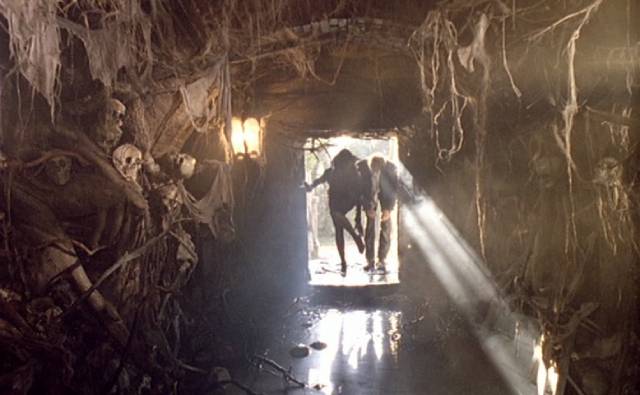
Dellamorte Dellamore (Michele Soavi, 1994)
It’s been years since I saw Michele Soavi’s Dellamorte Dellamore (aka Cemetery Man, 1994), the last of his four horror films made as the genre was waning in Italy. While the preceding three films – Stagefright (1987), The Church (1989) and The Sect (1991) – were all rooted in a recognizable contemporary world, Dellamorte Dellamore plunges into unhinged nightmare (laced with humour). Francesco Dellamorte (Rupert Everett) is caretaker of a cemetery in a small Italian town. In the opening sequence, we immediately discover that a major part of his job is to “kill” the dead who rise from their graves seven days after death. This is such a routine that he seems casual, almost bored, when a new corpse comes knocking at the door of his on-site hovel.
He’s assisted by his childlike underling Gnaghi (Francois Hadji-Lazaro), but hasn’t bothered to inform the town’s authorities about this odd development. When he sees a woman grieving at her elderly husband’s graveside, Dellamorte is strongly attracted to the widow, but his lack of social skills offends her. On repeated visits, though, she warms to him – particularly when he shows her an overgrown, decaying ossuary. Their relationship becomes complicated, and Dellamorte eventually grows nihilistic, coming to despise the living to the point where he drives into town for a bit of drive-by shooting…
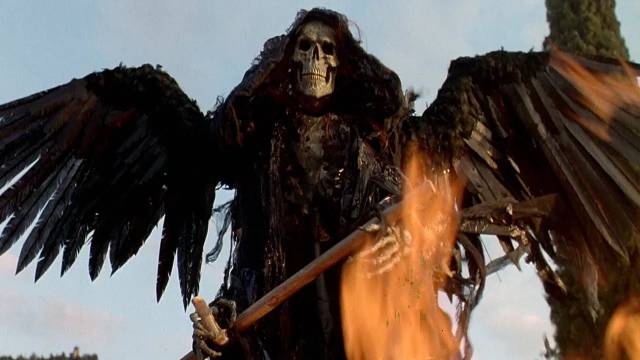
With the borders between life and death blurring and the living seeming no more appealing than the rising dead, Dellamorte and Gnaghi finally decide to drive away from the town … only to find themselves quickly standing at the edge of the world, with nowhere else to go. The film ends on a strange note which may be described as apocalyptically melancholic or melancholically apocalyptic.
Dellamorte Dellamore is the most original of Soavi’s horror films (while Stagefright, which I also just re-watched for the first time in years, is the most derivative – a formulaic slasher filled with irritating characters doing dumb things to get themselves killed) and I was looking forward to seeing it on Blu-ray to get the full benefit of its atmospheric imagery. But the transfer and encoding on the Shameless disk is very disappointing. Much of the film takes place in darkness and the blacks are murky, without much detail; contrast isn’t in the least subtle, so in many scenes you get the sense you’re only seeing a fraction of what should be in the image, and what you do see is an unattractive mess.
The disk includes a commentary from director Soavi and writer Gianni Romoli, plus an interview with Romoli and another with FX creator Sergio Stivaletti.
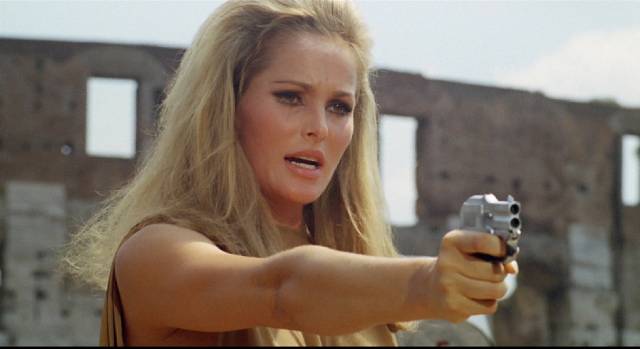
The 10th Victim (Elio Petri, 1965)
Strangely, while the Shameless Blu-ray edition of Elio Petri’s satirical science fiction movie The 10th Victim (1965) was released four-and-half years before Dellamorte Dellamore, the transfer is impeccable. The pop-art imagery is bright and detailed, giving the comedy of institutionalized murder a cheerfully sunny gloss which emphasizes the film’s critique of the commodification of our worse traits. Based on a brief story by Robert Sheckley, a master of blackly comic science fiction, with a script co-written by the masterful Tonino Guerra, Petri’s film is a romantic comedy which happens to have a background of sanctioned murder.
The Big Hunt – in which people sign up to be either hunter or victim, alternating through as many as ten competitions, with those who reach that goal winning a million-dollar prize – has been established as an official outlet for violent impulses since all war has been abolished. Formalizing and making public the private obsession of The Most Dangerous Game (1932), The 10th Victim spawned a whole sub-genre from Death Race 2000 to The Running Man and Series 7 and on to numerous movies like Gamer which place their protagonists into video games…
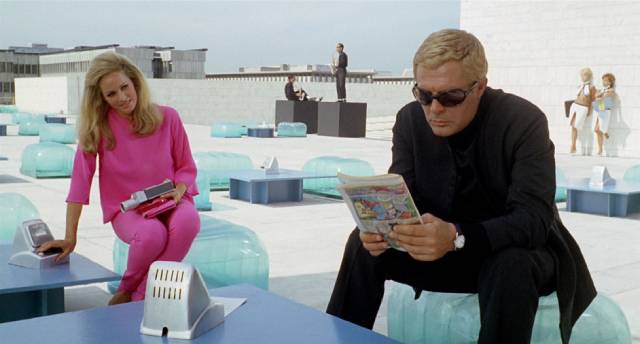
All those movies that followed now serve to obscure the effect The 10th Victim would have had when it first came out. The film operates essentially as a romantic comedy – the presence of Marcello Mastroianni reinforces that impression, playing on his relaxed image as a romantic lead – and yet the lovers fated to be together in the end are people so bored with life that they engage in this organized system of murder in an attempt to offset the ennui. This future world is a place of flavourless comfort, of bland modernity which speaks of a society drained of creative energy, in which everything including people has been reduced to commodity. While this clearly ties in with the more direct leftist critiques of Petri’s later films, it also suggests a precursor to Stanley Kubrick’s A Clockwork Orange (1971), which makes a similar use of existing architecture and inhuman urban spaces as a stage for violence as a form of entertainment.
In addition to the excellent transfer, the dual-format edition from Shameless includes an interview featurette which intercuts separate sessions with Petri’s widow Paola Petri and writer Kim Newman, covering Petri’s career as well as this particular film, reinforcing just how underappreciated he still is in the English-speaking world.
Comments